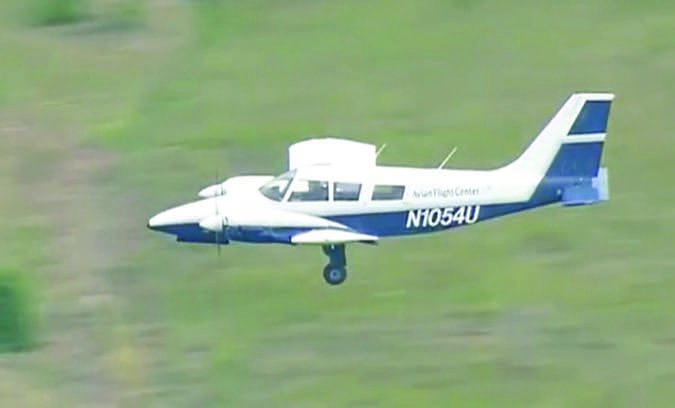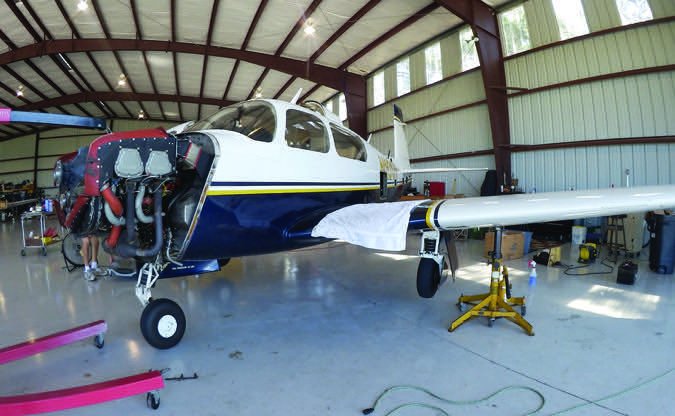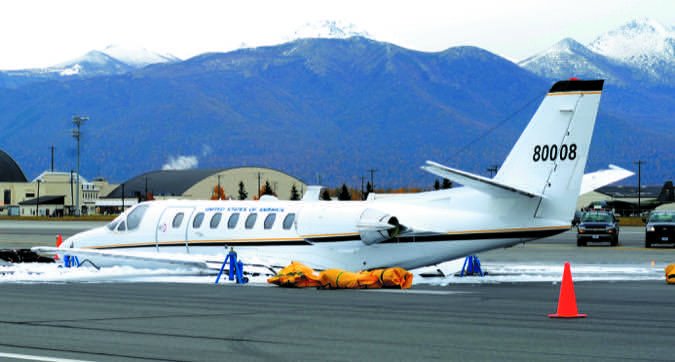Now that cockpit GoPro cameras are as common as iPads, it’s only a matter of time before someone posts the ultimate deer-in-headlights moment: the shock and terror of a pilot just commencing an inadvertent gear-up landing, otherwise known as the $60K slide.
It might be just as interesting if the camera kept running through the aftermath—the runway recovery, the call to the insurance agent and, ultimately, what to do if this happens to you.
Despite the worn clich of those who have and those who will, the risk of a gear-up landing is relatively low, although there are indications that the incidence of gear-ups is increasing. Fortunately, a gear-up landing—whether inadvertent or unavoidable—is hardly a life-threatening event. Injuries are all but unheard of and if the airplane is properly insured, it’s repairable. But not always. Older retracs with hard-to-find props and parts may be an economic loss after a gear-up. And parts are definitely getting harder to find.
In this report, we’ll sort through the accident record on gear-up landings and offer advice on what to do if you have one. Hint: In your own best interest, involve yourself intimately in the repairs. Don’t drop it off at the shop and let your insurer sweat the details, unless the shop has a good relationship with your insurer.
Accident or Not?
We swept 10 years worth of NTSB accident records on gear-up landings looking for useful clues in the data. Why do they occur? How do they occur? Can you avoid them? How many are there?
That last question is the most fraught, for everyone we spoke to for this report agrees that not all gear-up landings are reported to either the NTSB or even insurers. The reason is obvious. Pilots are worried about getting tangled up in an FAA enforcement action and if evidence can be quickly recovered from the runway and tucked away in the dark corner of a maintenance hangar, who’s to know?
The larger reason may be regulatory. NTSB 830, which defines reportable accidents and incidents, has specific language that precludes the requirement to report typical gear-up landing damage because it doesn’t meet the threshold of “substantial damage.”
If, on the other hand, a passenger or crew member was injured in the gear-up, rare as that is, or the airplane slides off the runway and takes out the glideslope shack, an NTSB filing is required. In that context, we’re not sure why so many gear-up landings actually are reported. But we’re glad they are, because without even this minimal data, we would have no inkling of why these things happen.
We looked at NTSB-listed gear-up landings that occurred between 2005 and 2015. We found a total of 156. That’s an average of 15 a year or a little over one a month. We suspect the actual occurrence is several times higher than that for the aforementioned reasons. You probably know that airlines aren’t immune from gear-up landings, but we mostly excluded these from the dataset.
Bizjets have their share, too, commonly related to worn parts or poor maintenance. The two-pilot jet set is relatively immune from the inadvertent, antenna-smearing, belly-skin-rashing ride down the pavement sans wheels. Training helps, we’re sure.
Ah, were it so with the weekend pilot flying the kid to college or practicing approaches, especially owners of Cessna 210s. Our review of the data shows that 44 percent of gear-up landings come as a complete surprise to the pilot, while 35 percent are what we might term unavoidable. In other words, the pilot was aware of some kind of gear problem and landed with the gear stowed in the wells or with one or more legs fully or partially extended.
The remaining 20 percent of gear-up incidents aren’t, technically, gear-ups if you define the occurrence as landing with no wheels at all or just partial extension. This category consists of pilots landing with what they thought was normal gear extension, only to have the wheels collapse. These are due to hard landings, side-loading in crosswinds, downlock failures, various kinds of poor maintenance and, according to some of the reports, no particular reason at all.
I Just Forgot
If there’s a common theme in gear-up landings, you’d have to be as dense as a mud fence to miss it: cockpit distraction. Time after time, pilots who’ve done the slide tell the FAA or investigators that something distracted them from their normal routine and lowering the wheels just got overlooked. More than one pilot said the gear-up warning horn was blaring away but went unnoticed until the airplane ground to a halt.
The hit parade of distractions? You name it, it’s on the list: Tower changed the runway; looking for traffic; worrying about a crosswind; impromptu CTAF debates; a go around; confused by a checklist; an odd smell in the cockpit. If the overwhelming majority of retractable pilots didn’t land with the wheels properly locked, you could be forgiven for thinking pilots have the attention span of gnats.

But even those who forget the wheels have probability on their side. Injuries and fire aren’t unheard of, but are so rare as to barely merit mention. The one fatal we found involved a Mooney pilot who realized he had neglected the wheels when the prop started chewing up the runway. He attempted a go around and flew into a tree.
We found three incidences of fire, one caused when the airplane slid off the runway and had the wing tanks sliced open by runway lights. One airplane burned after the slide was contained on the runway, evidently because of a minor fuel leak.
Although we couldn’t find meaningful data to support it, sliding on concrete or asphalt appears to cause less damage than risking a landing in grass, which can hide obstacles and cause parts of the aircraft to dig in, potentially flipping it or causing more damage.
The Gear Broke
Landing gear systems tend to be reliable, but the data shows they’re far from foolproof. That’s especially true if you’re flying a Cessna 172RG or 210, the twin poster children for gear that won’t play when the switch is moved to down. More on that in a moment.

As with gear-ups in general, there’s a discernible pattern in gear systems that malfunction. Mooneys and Bonanzas seem to suffer the fewest problems, Cessna singles the most and Cessna twins after that. The accident record is replete with stories of gear that wouldn’t come down or that collapsed on the runway, only to work perfectly when swung for a post-incident check.
Airplanes that use electric/hydraulic systems seem to be the most susceptible to gear extension failures. That would be Cessna and Piper and larger twins. For their singles, Beech and Mooney have favored electric motors driving transmissions that lower the gear with rods and bell cranks. All gear systems are susceptible to misrigging, but this appears less often as an issue in Beech and Mooney singles.
And that gets us to the Cessna 210. We found 27 gear-up incidents with the 210, or 17 percent of the total. The 210 is significantly over-represented in the data. Of the 27, only one was an inadvertent wheels-up landing. Fully 96 percent of the 210 gear-ups we found were due to some kind of mechanical failure in the system. And there’s plenty to fail.
We found examples of hoses that leaked, fittings that parted, doors that hung up, motors that burned up, linkages and downlocks that failed, modifications done improperly—it’s enough to start you shopping for a 206.
In the past, we’ve noted that the Cessna 210 gear is we’ll designed, but requires careful maintenance. As the fleet ages and parts get more expensive and difficult to get, our view is that it’s generous to call the Cessna gear system we’ll conceived. It clearly just isn’t as reliable as the Beech and Mooney designs. Even owners who are diligent about maintenance have gotten bamboozled by their mechanics.
In one case, a mechanic failed to install a replacement hydraulic line and in another, a gear door modification was done improperly. Owners do their part to keep the 210’s gear-up stats at the top of the leader board. One pilot took off with a near-dead battery and was shocked to discover the gear retracted only enough to knock it off the downlocks. His reward was a landing with partially extended gear which, in a 210, isn’t especially pretty.
Retractable versions of the Skyhawk and Skylane suffer similar problems. Our chart on page 12 reveals that the 172RG Cutlass actually has twice the gear-up rate as the 210. However, its low population distorts the data somewhat.
Piper systems, which use an electrically driven hydraulic power pack, don’t appear to have as many hydraulic issues as the Cessna systems do. They do suffer from broken links and failed downlocks.

The Aftermath
Baked into the actuarials by which insurance companies make profits despite boneheaded pilots is the realization that people land gear-up. Don’t worry, they’re used to it and nary an insurer exists that doesn’t know how to process a gear-up claim. That said, if you have a gear-up, there’s a right way to handle it and a less right way.
It will be a large claim. David Thibodeaux, who owns Flying T in North Texas, specializes in gear-up repairs and reports invoices between $60,000 and $90,000 for a typical single. Twins can be we’ll above that and costs are escalating because parts are ever more difficult to find.
Our in-house insurance expert, Jon Doolittle, of Sutton James, says that underwriters are split on whether they’re seeing more gear-up landings. But there’s discernible worry that the recent passage of the BasicMed rule will have the positive effect of keeping older pilots flying longer but the negative effect of more gear-up landings due to distraction and memory issues in older airmen. “It doesn’t take someone almost running into an airliner to cause a gear-up,” Doolittle observes. “Now it could be a Mylar balloon.”
Doolittle says that what data exists suggests that pilots who suffer gear-up landings tend to be high-timers and perhaps with high time in type, but currency is an issue as owners fly less. Our sweep of NTSB data was inconclusive on this point. Nonetheless, insurers cover gear-up landings, just don’t expect the policy to make you entirely whole.
A basic principle in the insurance business is that policies are supposed to cover reasonable, documented losses but not leave the policy holder better off than he was when the claim was filed. The so-called betterment doctrine makes things sticky when damage not caused by the gear-up has to be repaired.
For example, gear-up landings almost always trash the prop, requiring an engine teardown and inspection. If the inspection reveals a required AD against a part like a cam, crankshaft or magneto that wasn’t damaged by the gear-up, the insurer is likely to balk at paying for it, even though it will pay for the basic inspection. If the cam is trashed by spalling or corrosion, same deal. You’ll have to replace it, but it won’t be covered on the claim.
The same is true of airframe parts that might be damaged or worn and in need of replacement, but weren’t damaged by the gear-up. Pretzeled props are routinely covered in gear-up landing claims, but increasingly, they are being prorated, according to Doolittle’s findings. That means if the prop was halfway to TBO, the lower value may be subtracted from the insurance claim.
Doolittle says that owners should expect to pay something after a gear-up claim. But to minimize that something, owners should remember that it’s not the insurer’s job to find a shop, negotiate repair prices and scope and oversee the work. That’s on the aircraft owner.
Often, the work is done where the gear-up happens, but it doesn’t have to be. If the aircraft is not heavily damaged, it can be flown elsewhere for the repair, under a ferry permit.
This gives the owner the option of taking the airplane to a familiar shop that’s closer to home or one that specializes in this type of repair. Flying T is one such shop and Thibodeaux told us he much prefers to deal with a known insurance company than an owner who wants to nickel and dime every aspect of the repair work.
Lacking a specialty shop, however, the insurer won’t necessarily intercede in any of this unless the estimates are outside the company’s reasonable expectations. They may ask for detailed estimates before the work is approved. And remember, everything is negotiable, both with the insurer and the shop doing the work. Doolittle says owners who remain involved in the repairs in detail and document why they think certain parts should be replaced when they otherwise might not be will get a fairer shake than those who just drop the airplane off and ask for a call when it’s done.
“That’s the difference between a good company and a very good company,” Doolittle adds. “The very good ones are more likely to step up and make it right.” Those very good companies might charge slightly higher premiums—or not—but the payoff will come when they don’t peck the owner to death on insurance claim line items.
The aviation insurance industry is currently over-served and intensely competitive, a business environment that makes companies think twice about denying too many claims. Word gets around, especially among independent agents. Just don’t assume companies will step up without being nudged in the right direction by a cooperative attitude, good owner legwork and ready documentation.
About That Engine. . .
Depending on the make and model, tending to the engine after a gear-up may be the most expensive part of the job. If it’s a twin, make it times two.
Make no mistake, after a gear-up landing in which the prop has been damaged, even a little, the engine will have to be torn down and inspected and insurers aren’t going to skip this step.
But they’re also not going to buy you an overhaul. Following the betterment doctrine, the insurer will pay for the prop and the labor to T&I the engine. It will also pay for damage done to the engine as a consequence of the sudden stoppage. That could be a cracked case or crank, broken gears or other parts or nothing at all if the inspection yields no damage.
Shops we checked with told us that as much as half of their work is prop strike inspection and the labor to do that can total between half and two thirds of overhaul cost, presenting the owner with a dilemma.
Since the engine is torn down, doesn’t it make sense to go ahead and overhaul it? It might, especially if the engine is past mid-time. Add whatever parts are necessary—cylinders, cams, lifters and so on—and the labor to put it all back together is on the insurance company’s dime. But they aren’t the hook for new or even service-limits overhaul parts. They may also insist on some proration on parts that are serviceable with repairs.
How often is damage found? “I would say rarely. We see it more on Continentals than Lycomings,” says Penn Yan Aero’s Bill Middlebrook. Still, crankshafts occasionally break at the flange.
Middlebook and other shops told us they’re constantly in discussions with insurers over what has to be done and what will be paid for in the claim. Rare is the engine that’s opened up with no evidence of problems in need of attention.
Owners go both ways on whether to overhaul or just settle for the T&I. Penn Yan sends two quotes, one for the parts the insurer will pay for and a second that the owner has to cover.
At Certified Engines in North Perry, Florida, they do the same. “But the keyword we hear is: betterment,” says Certified’s Allen Weiss. Insurers will sometimes dicker and get down into the weeds over the list of parts. For the most part, says Weiss, insurers pay what they’re supposed to and everybody’s happy.


